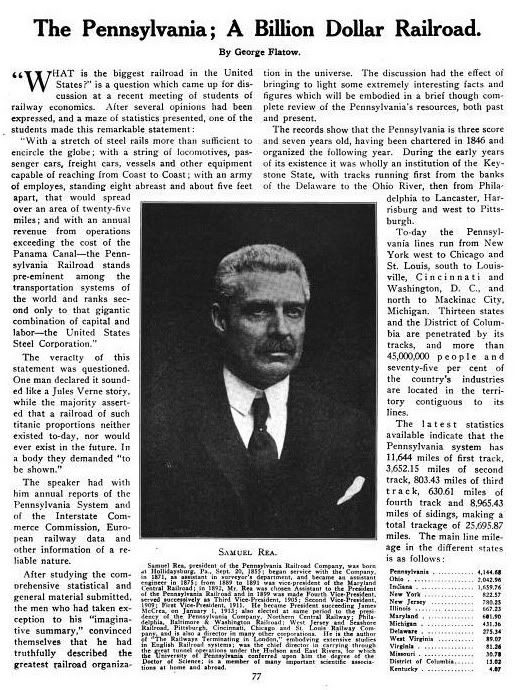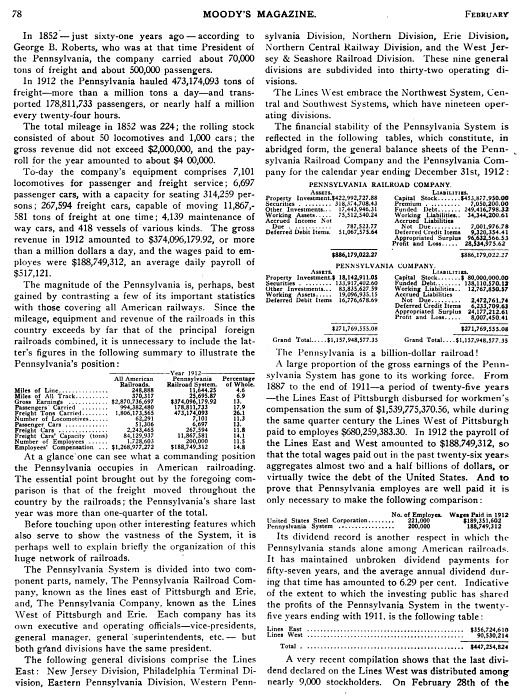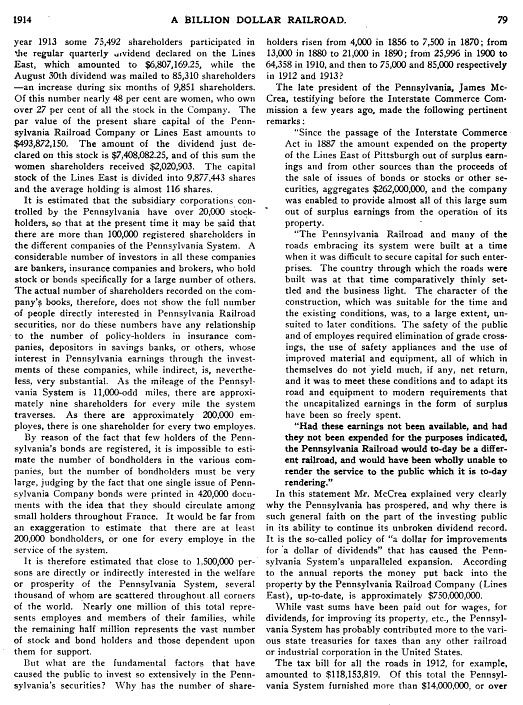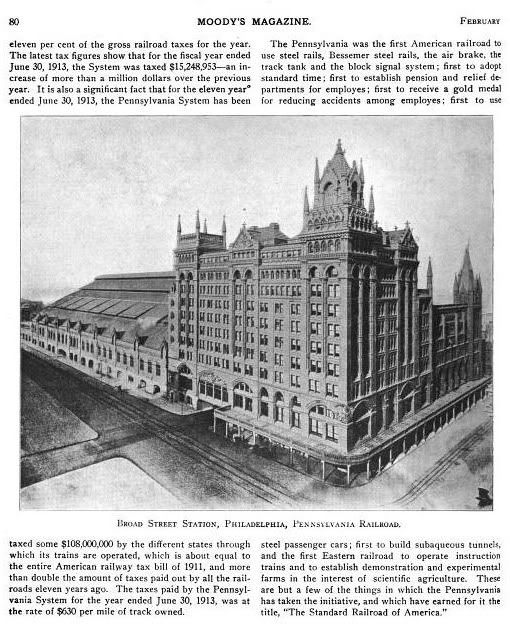At one time, the PRR was THE railroad in the US. What was the ace in the hole for The Pennsylvania? Was it the trunk line to Chicago? Hauling minerals, such as eastern coal? Hauling farm produce and factory goods? Hauling passengers (in the early days)? Or was did the PRR just have what a stock broker would call a well rounded portfolio of traffic?
All the above plus the way it marketed itself. Who named it “The Standard Railroad of the World”? Not the New York Central or England’s LMS but the advertising and marketing geniuses of the Pennsylvania Railroad! But PRR was, to many, anything but standard…no body else had GG1’s, for instance; who else had a wired six track right of way with 100 mph running and a single track, non electrified branch off that line with no more than 80 lb rail and a 25mph speed limit? The PRR could better be argued by outsiders as being the most “collective” railroad or most “variety” railroad. In its advertising and marketing, the phrase was one that set a statement of pride and excellence rather than the bellweather of operations and equipment.
Murphy,
I did not grow up in PRR territory, but would highly recomend the “Triumph” series by Roberts.
What the PRR had was VOLUME, and that was mostly due to its route structure which directly served New York to Washington DC and everything between. It was then and still is the greatest concentration of consumers in the US. PRR dominated Pittsburg, seat of the American Steel Industry from 1850 to 1970. PRR dominated oil and petroluem traffic from PA which was virtually the entire industry from 1850 to 1900. PRR had best coverage of the Appalachian coal fields.
In short location, location, location which generated traffic, traffic, traffic. PRR was built late in the game but had superb management between 1845 (J. Edgar Thompson) and 1910. You have to give that management credit for the route structure.
Mac
Two word answer:
Pittsburgh Steel
The PRR was created to service Pittsburgh industry, both getting raw materials in, and finished products out. Everything else was a side show. As the power and money produced in Pittsburgh climbed, so did the the PRR. When the Pittsburgh economy started to change from industrial to service post WW2, the PRR’s traffic base dried up along with their finances.
The Steel Production of Pittsburgh was definitely a powerful force in the wealth of the Pennsy, but I would argue that its lines from Pittsburgh to the West, and anchored there by St. Louis. and the vein-like structure of its lines aqnd branches in Ohio, across Indiana, Illinois created a powerful gathering net for movement over Pennsy rails. From Cincinnati on the South to Chicago to the North, and East towards it Eastern lines.
Pennsy had a large system with a high speed (for the day) network of fast Passenger trains that it marketed with style and lavish efforts. Locomotives that were impressive and designed by the likes of Raymond Loewy ( S-1, T-i, Streamlined K-4’s ) . They made riding their trains something special with their marketing campaigns. [2c]
When PRR called itself the Standard Railroad of the World, it was stating that it was the railroad that was setting the standard for others to try and live up to.
I would submit, though, that the lines east of Pittsburgh and Cleveland supported the rest of the system. The PC merger kept a lot of it alive, because the PRR guys had control at least up until the bankruptcy. But when Conrail took over, with well-publicized plans to abandon specific parts of the system, the ex-PRR lines took quite a hit, suggesting that these lines were probably inferior to their alternatives. Of course, the decline of industry in the area contributed to the declines that resulted in the mergers and bankruptcies, but the success that Conrail became was done without the benefit of the old PRR line west of Pittsburgh and Cleveland, for the most part.
The PRR hauled steel, yes, but also lots of coal, lots of passengers, lots of so many things. Its map and locations allowed it to have to handle a wide variety of raw materials and manufactured goods plus commuters and long distance passengers. It was so urban and so suburban and so rural, there really wasn’t a standard!
The PRR had the foresight to diversify itself instead of relying on hauling one or two commodities. It did not trap itself and rest its fortunes as a conveyer belt of coal like almost all of the Anthracite roads (CNJ, Lehigh Valley, Lackawanna, NYO&W, Reading, Lehigh & Hudson, L&NE, NYS&W). It also wasn’t a “Buffalo Road” whose long distance livelihood wasn’t at the mercy of Great Lake boats and Midwestern road connections (i.e. Lehigh Valley and Lackawanna). PRR also saw the benefit in long haul transportation instead of short haul, terminal-like operations. Steel helped the railroad but unlike other steel roads (P&LE, B&LE), the PRR could feed the mills with coal and ore plus ship the finished products to East Coast markets.
The PRR also saw and pursued smart growth strategy. The original Main Line was between Harrisburg and Pittsburgh. Management saw that to capture more traffic, they had to reach port cities like Philadelphia and Baltimore. Even though Philadelphia was their home base, New York was where the money was so they acquired lines to New York. After gaining control of the Philadelphia, Wilmington & Baltimore, PRR management knew they had to get to Washington not only for the prestige of serving the nation’s capital, but it gave the railroad important freight connections to the south with the forerunners of the Southern, C&O, and the RF&P. Same thing with aquiring “western” railroads to Chicago and St. Louis, those cities allowed the railroad connect with numerous other railroads outside of the company’s home turf.
The PRR management also didn’t bleed the coffers dry to boost their own riches (the robber barrons
I will add one more thing that the PRR had. Some of the smartest and most talented engineers based in Altoona at the Juniata Shops. They designed some of the best locomotives ever built. With the smarts to buy the Belpaire firebox the company had a real winner and the engineers in Altoon took full advantage of its capbilities.
Many of the advantages that PRR had at one point in history became heavy burdens to carry:
-
Extensive passenger train routes.
-
Many branch lines to feed the mainlines.
-
Heavy reliance on the steel industry.
-
Northeastern United States franchise.
It is fascinating to take a look at a 1940’s -50’s Official Guide and see how extensive their passenger operations were. Not to change the subject of the thread, but the railroad was not able to change as the nation’s economy changed in the 1950’s and beyond.
Ed
The biggest asset to the PRR. was they had railroad men. Promotions from within the company and the knowledge of the railroad business is the greatest asset. They didn’t let accountants and pencil pushers get in the way. They concentrated on the movement of goods and people and not so much the bottom line. Maybe that was the downfall? I believe it was a small portion of the downfall. Recognizing what needed to be done to better serve its customers was the greatest accomplishment. They had more of one class of freight car then most roads had cars. They at one time more 2-8-0 locomotives on the roster then other roads had motive power and cars. They were the biggest but not necessarily the best. They had their share of short comings. Their lack of using articulated locos for mainline freight for one example. Using locos in multiple was a big drain on man power that other roads found out first. Perhaps it was the railroad man mentality of the management that kept the crews in the second and third cab instead of one crew for each train.
Books have been written on the rise and fall of the railroad.
Pete
I’d say the latter - and all of the above - plus a generous helping of good luck. In addition to some of the preceding comments, I offer the following:
- Charles S. Roberts (died last year) in his PRR Triumph I book advances the thesis that the early PRR officials - John Edgar Thomson and associates, circa 1850 - anticipated the major flow of traffic would be eastbound, down the Horse Shoe Curve grade - not westbound/ up it, which gets all the attention and drama. He points to the ruling EB grade of only about 1.0%, as compared to the 1.8% ruling grade WB as evidence of that thought. I haven’t accepted that proposition yet - I think it’s more a result of just what was reasonably achievable with the terrain they were confronted with and the construction methods of the day, than a planned balance or trade-off of those grades - but there may be some merit to it;
- Again per Roberts, the PRR was very conservative in managing its finances - typically paying out as dividends only 1/2 of what was earned, and investing the rest back into the business. Likewise, its capital structure was conservative - no more than $1 of debt for each $1 of equity. For a little more on that - and other characteristics of the early PRR - see this essay on Thomson, at: http://www.philadelphia-reflections.com/blog/2021.htm ;
- At ‘build-out’ by th
Don’t forget that, unlike parts of the NYC, the PRR system had very viable alternative routes by rivals like the Reading and Lehigh Valley that were also conveyed to Conrail. The reasons are many and varied–there’s no real idea that the PRR lines were inferior, just not always the best choice with so many competitors in the region.
The traffic density on many of the PRR’s western lines was corn field granger compared to its Pittsburgh area lines.
An example: The PRR had a branch line that ran 20 miles south from Pittsburgh that ended in Washington, PA trough the (then) heavily industrialized Chartiers Creek Valley. At the height of WW2, they were moving a 1000 carloads of freight per day that originated from industries along that single 20 miles of line. Multiple that times all the other industrial lines located in the Pittsburgh region, plus the lines that serviced Big Steel in the Monongahela, Allegheny, and Ohio River valleys, plus all the mine runs, and you may begin to understand the importance of the Pittsburgh Region to the success of the PRR.
The thing was, the PRR didn’t have this big party just to themselves. There was so much freight traffic produced around Pittsburgh, that the B&O, the P&LE, the Montour RR, and the WM had more carloads than they could handle too. Unless you witnes
That has more to do with geology than any engineering effort on J. Edgar Thompson.
The Allegheny Front is the remnants of an ancient mountain range that towered 7 miles high when formed 280 million years ago. All that is left is a 3,000’ to 5,000’ high escarpment that rises slowly from the west, and drops off steeply into the eroded core of the ancestral Allegheny Mountain. The East slope is always steeper than the West slope along the entire front. The B&O’s Sandpatch and 17 Mile Grades have similar profiles.
You can see this by traveling the PA Turnpike. Westbound, the climb is steep up to the Allegheny Tunnels. After the tunnels, the grade slowly descends until you hit the next major anticline, which is the 3000’ high Laurel Ridge Mountain. The Turnpike has to make the steep climb up and over the Laurel Ridge, but the PRR (NS) and B&O (CSX) travel through it via 2000’ deep water gaps dug by the Conemaugh and Youghiogheny Rivers.
While Pittsburg was a big part of the PRR, Philly was many times higher.
During the war years Philly was one of the center manufacturing centers as well as the number 1 shipping port. Getting materials and finished goods to the factories and shipyards was the job of the PRR.
I was luck enough to live near a 4 track main of the PRR as a kid. I watched it shift from PRR to Penn Central and later Amtrak/ NS.
There was nothing like seeing the GG1’s roar by, especially when consisted with freight.
This thread has wandered far and wide from the premise of The Standard Railroad. It was The Standard Railroad of the World because the advertising/marketing agency said so. After that is said you’ve got read your history of the railroad and railroads in general. No one started out to build a railroad from New York City to Chicago. Overtime railroads were combined end to end, extensions were built or bought . The center line of the PRR’s service area had coal, iron, lake and ocean harbors, big cities and rural farms and towns. Yes, the idea was that agricultural products would flow from west to east, that the manifest density was to send people west and goods east. But as the country developed, resources discovered, and new industries built from the developements and discoveries, so did the railroads in general The PRR was many raliroad built and bought and absorbed and operated within the name Pennsylvania Railroad. Some of what we knew of the PRR in the end was as much luck of acquisition as it was shrewed planning of the hierarchy of the Golden Age. To give any single fact the reason for its ascent to the largest railroad of the east deflects attention from all that made up the PRR. A passenger railroad between NY, Philadelphia, D.C. and the South, or to the west from Philadelphia; a commuter railroad out of the larger on line cities; a coal hauler from eastern PA to both the Atlantic and Great Lakes harbors as well as to the inland steel mills of Johnstown, Pittsburgh, and into Ohio; an ore hauler from the Great Lakes to the steel mills and a steel hauler after that; hot shot merchandise freight, automobiles, and agricultural products from the mid west to the east and imports from the coast to the midwest. If there were a standard, and the PRR was it, it was because it did the standard work of any and all other railroads. It was just that someone in their advertising or marketing department saw that and came u
Philly never had the industrial output that Pittsburgh had.




On another website and regional group forum for the NS between Altoona and Johnstown, PA - http://finance.groups.yahoo.com/group/nsaltoonajohnstown/ , a college student - Josh Holland - has compiled and posted “train logs” from time to time. Most recently - this past Friday, 15 April 2011, from 0630 AM to 6:50 PM - he did one at CP COVE = MP 116 on the NS Pittsburgh Division, which is a few miles northwest of Harrisburg, PA, Enola yard, Rockville Bridge, etc. Over the weekend I compiled a summary of it, which is repeated below. Even though it’s 'today" and not 100 years ago, I still think it’s instructive on the volume - 33 trains in just over 12 hours ! - and mix of traffic that the PRR, then PC, ConRail, and now NS see on this core segment of that system. Note that with regard to traffic balance and direction, of the 5 trains that could be identified as loads, 4 were EB and only 1 was WB - a work train of rail at that; and of the 7 trains that were identified as empties, 5 were WB and only 2 were EB.
- Paul North.
Summary of Josh’s train log for 12 hrs. 20 mins. = 12.33 hrs.:
33 trains - 16 WB, 17 EB
Locomotives - 76, 37 WB, 39 EB
Intermodal - 13, 7 WB, 6 EB
Coal - 4, 3 empty WB, 1 loaded EB
RoadRailer - 1, 0 WB, 1 EB
Ethanol - 2, 1 empty WB, 1 loaded EB
Automobiles - 2, 1 empty WB, 1 loaded EB
Manifest - 5, 2 WB, 3 EB
Steel Slabs - 1, 0 WB, 1 empty EB
Work Train - 1, 1 loaded WB, 0 EB
Passenger - 2, 1 WB, 1 EB
Grain - 1, 0 WB, 1 loaded EB
Trash - 1, 0 WB, 1 empty EB
To the extent we can tell loads vs. empties for 12 of these trains, note that
the loads are predominantly EB - 1 Coal, 1 Ethanol, 1 Automobiles, 1 Grain = 4
total EB loads, plus 1 Work train loaded WB; whereas the empties are
predominantly WB - 3 Coal, 1 Ethanol, 1 Automobil